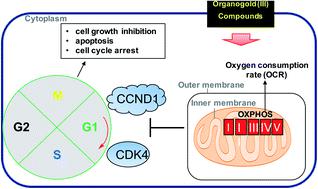当前位置:
X-MOL 学术
›
Chem. Sci.
›
论文详情
Our official English website, www.x-mol.net, welcomes your feedback! (Note: you will need to create a separate account there.)
Cancer cell-selective modulation of mitochondrial respiration and metabolism by potent organogold(III) dithiocarbamates
Chemical Science ( IF 8.4 ) Pub Date : 2020-09-18 , DOI: 10.1039/d0sc03628e Randall T Mertens 1 , Sean Parkin 1 , Samuel G Awuah 1, 2
Chemical Science ( IF 8.4 ) Pub Date : 2020-09-18 , DOI: 10.1039/d0sc03628e Randall T Mertens 1 , Sean Parkin 1 , Samuel G Awuah 1, 2
Affiliation

|
Metabolic reprogramming is a key cancer hallmark that has led to the therapeutic targeting of glycolysis. However, agents that target dysfunctional mitochondrial respiration for targeted therapy remains underexplored. We report the synthesis and characterization of ten (10) novel, highly potent organometallic gold(III) complexes supported by dithiocarbamate ligands as selective inhibitors of mitochondrial respiration. The structure of dithiocarbamates employed dictates the biological stability and cellular cytotoxicity. Most of the compounds exhibit 50% inhibitory concentration (IC50) in the low-micromolar (0.50–2.9 μM) range when tested in a panel of aggressive cancer types with significant selectivity for cancer cells over normal cells. Consequently, there is great interest in the mechanism of action of gold chemotherapeutics, particularly, considering that DNA is not the major target of most gold complexes. We investigate the mechanism of action of representative complexes, 1a and 2a in the recalcitrant triple negative breast cancer (TNBC) cell line, MDA-MB-231. Whole-cell transcriptomics sequencing revealed genes related to three major pathways, namely: cell cycle, organelle fission, and oxidative phosphorylation. 2a irreversibly and rapidly inhibits maximal respiration in TNBC with no effect on normal epithelial cells, implicating mitochondrial OXPHOS as a potential target. Furthermore, the modulation of cyclin dependent kinases and G1 cell cycle arrest induced by these compounds is promising for the treatment of cancer. This work contributes to the need for mitochondrial respiration modulators in biomedical research and outlines a systematic approach to study the mechanism of action of metal-based agents.
中文翻译:

强效有机金 (III) 二硫代氨基甲酸盐对癌细胞线粒体呼吸和代谢的选择性调节
代谢重编程是癌症的一个关键标志,它导致了糖酵解的治疗目标。然而,针对线粒体呼吸功能障碍进行靶向治疗的药物仍未得到充分探索。我们报告了十 (10) 种新型高效有机金属金 ( III ) 配合物的合成和表征,这些配合物由二硫代氨基甲酸酯配体支持,作为线粒体呼吸的选择性抑制剂。所用二硫代氨基甲酸盐的结构决定了生物稳定性和细胞毒性。当在一组侵袭性癌症类型中进行测试时,大多数化合物在低微摩尔 (0.50–2.9 μM) 范围内表现出 50% 抑制浓度 (IC 50 ),并且对癌细胞比正常细胞具有显着选择性。因此,人们对金化疗药物的作用机制非常感兴趣,特别是考虑到 DNA 并不是大多数金复合物的主要靶标。我们研究了代表性复合物1a和2a在顽固性三阴性乳腺癌 (TNBC) 细胞系 MDA-MB-231 中的作用机制。全细胞转录组测序揭示了与三个主要途径相关的基因,即:细胞周期、细胞器裂变和氧化磷酸化。2a不可逆地快速抑制 TNBC 中的最大呼吸,对正常上皮细胞没有影响,表明线粒体 OXPHOS 是一个潜在靶点。此外,这些化合物诱导的细胞周期蛋白依赖性激酶的调节和G1细胞周期停滞有望用于癌症的治疗。这项工作有助于满足生物医学研究中对线粒体呼吸调节剂的需求,并概述了研究金属制剂作用机制的系统方法。
更新日期:2020-10-07
中文翻译:

强效有机金 (III) 二硫代氨基甲酸盐对癌细胞线粒体呼吸和代谢的选择性调节
代谢重编程是癌症的一个关键标志,它导致了糖酵解的治疗目标。然而,针对线粒体呼吸功能障碍进行靶向治疗的药物仍未得到充分探索。我们报告了十 (10) 种新型高效有机金属金 ( III ) 配合物的合成和表征,这些配合物由二硫代氨基甲酸酯配体支持,作为线粒体呼吸的选择性抑制剂。所用二硫代氨基甲酸盐的结构决定了生物稳定性和细胞毒性。当在一组侵袭性癌症类型中进行测试时,大多数化合物在低微摩尔 (0.50–2.9 μM) 范围内表现出 50% 抑制浓度 (IC 50 ),并且对癌细胞比正常细胞具有显着选择性。因此,人们对金化疗药物的作用机制非常感兴趣,特别是考虑到 DNA 并不是大多数金复合物的主要靶标。我们研究了代表性复合物1a和2a在顽固性三阴性乳腺癌 (TNBC) 细胞系 MDA-MB-231 中的作用机制。全细胞转录组测序揭示了与三个主要途径相关的基因,即:细胞周期、细胞器裂变和氧化磷酸化。2a不可逆地快速抑制 TNBC 中的最大呼吸,对正常上皮细胞没有影响,表明线粒体 OXPHOS 是一个潜在靶点。此外,这些化合物诱导的细胞周期蛋白依赖性激酶的调节和G1细胞周期停滞有望用于癌症的治疗。这项工作有助于满足生物医学研究中对线粒体呼吸调节剂的需求,并概述了研究金属制剂作用机制的系统方法。



























 京公网安备 11010802027423号
京公网安备 11010802027423号